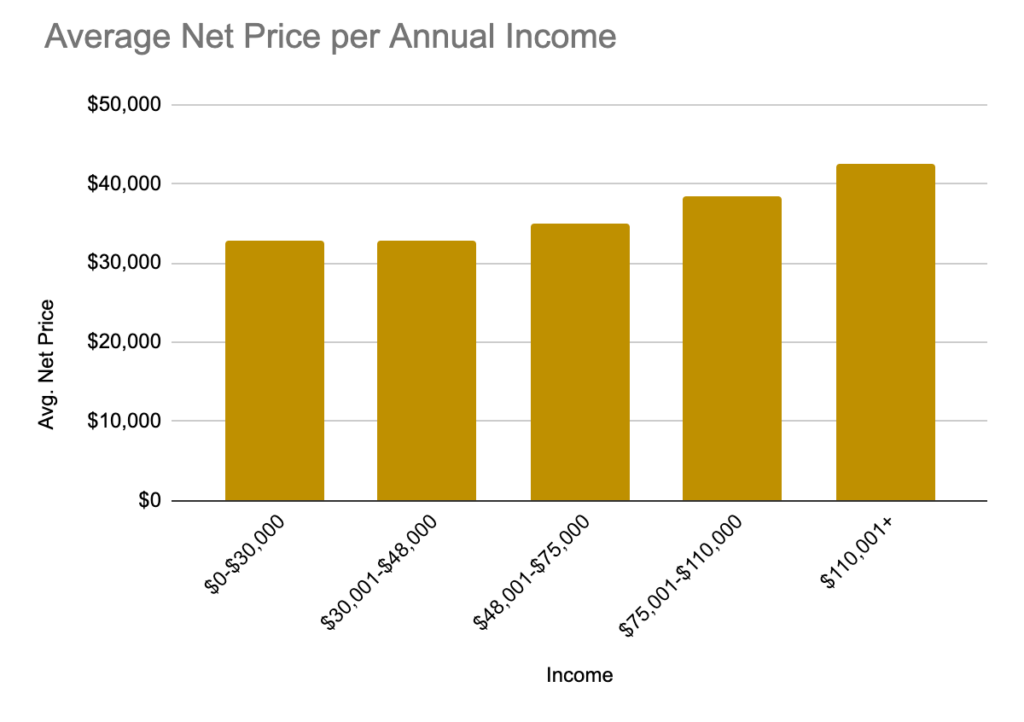The first time Gabriella Colello applied to Quinnipiac University, she was a senior in high school. Quinnipiac was just one of the handful of schools she’d been considering, but when her acceptance finally came, she knew it wouldn’t be her home for the next four years.
The reason? Her $7,000 per year financial aid package.
Quinnipiac’s strategic plan calls for the university to promote “inclusive excellence.” But student experiences show that the school has a long way to go.
According to data published in the New York Times, the median income of a Quinnipiac family is almost $150,000. Over half the student body, 66%, come from the top 20%. Only 2% of the undergraduate population is in the bottom 20%.
Additional data from ProPublica’s Debt by Degrees tool shows that less than 16% of Quinnipiac students receive the Pell Grant, an educational supplement from the government to help low-income students pay for college.
Carrie Warick, director of policy and advocacy for the National College Attainment Network, which works to increase postsecondary education options for low-income students, found Quinnipiac’s statistics to be low.
“When you consider that one-third of higher education students receive the Pell Grant, 15% is fairly low,” she said.

These figures show that low-income students are a distinct economic minority at Quinnipiac.
Colello comes from a working-class family: her father, Joseph Colello, is a supervisor at Hamden Public Works and her mother, Kaye Colello, teaches eighth grade at Hamden Middle School. The family could not afford Quinnipiac, which cost $63,770 when Colello graduated high school in 2017.
The $7,000 award wasn’t even a drop in the bucket.
Instead, Colello chose to attend the University of Connecticut, the in-state tuition being far more manageable than that of any private university.
Life, however, intervened.
Just weeks into her freshman year at UConn, Colello learned that her mother, a Quinnipiac alumna, former U.S. Marine and Persian Gulf War veteran, was diagnosed with a benign brain mass caused by an environmental disaster at her military base. After three semesters at UConn, she withdrew from school to care for her mother full-time.
The second time Colello applied to Quinnipiac was in August of 2020. Her mother recovering and an associate degree in paralegal studies from Naugatuck Community College under her belt, she applied as a transfer student with the hopes of majoring in political science and law and society.
“Between different grants and scholarships, I get about $25,000 per year,” Colello said. “It’s the most money a transfer student is able to receive.”
But even with a maxed-out scholarship, living at home and an educational supplement from the U.S. Department of Veterans Affairs that she receives because of her mother’s 100% service-related disability rating from the V.A., Colello still needs to borrow almost $25,000 a year to pay tuition.
“The only reason I was able to choose Quinnipiac wasn’t because financial aid covered or met my needs, but because of the money I receive from the V.A.,” she said. “I pay the school with pity money from the government.”
By the time she graduates, Colello will have about $55,000 in student loans.

Her situation is not unique.
Many Quinnipiac students say the university has not only failed at creating an economically diverse campus, but one that is respectful and inclusive of those from varying financial situations.
“The nicest way I could describe the culture here at Quinnipiac is white people of privilege who have never had to worry about being paycheck-to-paycheck, because they come from the kind of money that I can barely comprehend,” said Madison Stout, an applied business and political science double major.
Stout comes from a working-class family in Berwick, Pennsylvania, and finances played a key role in her college choice.
“I grew up in an area where the cycle of poverty is all I ever knew and all everyone there ever knows. I would do anything to not end up in that situation,” she said.
Stout eventually enrolled at Quinnipiac because a scholarship helped to fund her tuition and she could live at her sister’s house in nearby Wallingford, Connecticut.
“It’s weird to say that money was an issue for me and then to have ended up here, where money means so little for so many kids,” she explained.
Stout’s college career has not been that of a typical Quinnipiac student. Since her first year, she’s worked three jobs to make ends meet, on top of being a full-time student.
“I’d say that the multitasking and the daily reminder of what I have to do to be here makes me well rounded, but I wish it didn’t have to. I feel like I’m missing out on the opportunities my peers have to make memories and study and simply be,” she said.
Even with scholarship and free housing, Stout said she will hit $80,000 in student loans by the time she graduates. She is currently at just under $65,000.
“Three years in [to this degree], I think I’ve realized that I might claw my way out of the cycle of poverty, of small-town generational [poverty], just to find my way in another,” Stout said.

Recruiting Low-Income Students
Eric Sykes, Quinnipiac’s vice president of enrollment management, says that socioeconomic diversity plays a crucial role in developing the critical analysis skills students come to college for in the first place.
“When you look at the experiences of students at the campus, the most influential dynamics that impact student learning aren’t faculty to student, they are student to student,” Sykes said. “Students learn from each other. For that reason, it is extremely important that the backgrounds, experiences and development of our students be as diverse as possible … Socioeconomic diversity contributes importantly to our perceptions and understanding of the world. It’s crucial that sharing these perspectives from multiple viewpoints is encouraged in order to produce better educational outcomes for all.”
Sykes also pointed out steps Quinnipiac is implementing to make the school more accessible to low-income students.
“QU does recruit low-income populations in a variety of ways.” said Sykes. “You have to consider the admission cycle from start to finish … Low-income students often have a different path to college. They are less likely to take preparation tests and are more likely to be questioning whether or not college will be an option,” he said.
Sykes joined Quinnipiac in 2019, and he made boosting enrollment among low-income students a priority. The school has forged relationships with local community colleges to make the transfer process easier and with high schools covered under the New Haven Promise program that helps low-income students with tuition.
Still, the bar becomes higher for low-income students. Tuition has jumped by 3% and room and board by 3.3% since 2017. Information sessions that explain financial aid can’t pay the ever-increasing bills.
“Active recruitment doesn’t matter if you aren’t offering financial aid packages to back it up,” Warick said.
These numbers reveal larger issues that many universities have yet to confront.
Any university, public or private, that receives Title IV funds from the government is required by law to make their average net price information available. The U.S. Department of Education’s website breaks down this information into quintiles based on a family’s annual income.
According to data from the U.S. Department of Education, Quinnipiac’s 2021 average annual cost is $39,307. But that’s not the cost that all students or their parents pay.
For a family with a household income of up to $30,000, the average cost to attend Quinnipiac is $32,775, almost $3,000 more than they earn per year.
For families making between $30,001 and $48,000, the average cost increases marginally, from $32,775 to $32,866.
As the annual family income increases, so does the average cost of tuition, but only ever so slightly. Families making over $110,000 per year pay, on average, an annual cost of $42,511 to attend Quinnipiac, less than $10,000 more than those living close to the poverty line.

“This shows that lower-income students are being charged more per quintile than their middle-class counterparts,” said Warick. “When you’re charging more for one year of college than a low-income family makes during that year, there’s no wonder those students aren’t able to come.”
With high annual costs such as these, students, especially low-income students, are left taking out considerable loans to finance their education. Bill DeBaun, NCAN’s director of data and evaluation, said that this makes the finishing of a degree even more important.
“Completion, then, is especially critical. A ‘debt with no degree’ situation, where a student drops out before receiving the credential that would likely increase their earnings, is a worst-case scenario,” he said. “Institutions need to do everything they can to see their commitment to a student through and ensure they make it to commencement.”
Kelsey Paul, a former English major, left Quinnipiac after learning her financial aid package couldn’t be applied to remote learning, even though the COVID-19 pandemic made it necessary.
Upon receiving her acceptance to Quinnipiac, Paul wondered whether the school’s high tuition would keep her from attending. After weeks of creating budgets and spreadsheets, she ultimately decided to enroll.
“I decided to enroll because of the many programs I was excited to be involved in, like the honors program as well as the 3+1,” she said.
Her excitement was short-lived.

“I declared remote study for the fall semester and logged onto self-service to find my grant, which was crucial to my being able to afford Quinnipiac, gone. My financial aid was literally the only reason I could attend Quinnipiac,” she said.
Quinnipiac, she explained, did not alert her about her loss of financial aid.
“Especially as a remote student, getting in touch with financial aid representatives was nowhere near easy,” Paul said.
Paul spent weeks calling the school’s financial aid office to better understand why her aid had been revoked. No one answered.
“Even when I saw that they were back in the office at the end of the summer, I never heard back. I sent emails and still didn’t get any response. I even had my mom call and email, hoping they would be more responsive to a ‘real adult,’” she explained. “They weren’t.”
Just four days before the start of the new semester, Paul received what she described as a “generic” email. Just two sentences in length, it explained that remote status meant her financial aid would disappear.
“If I had known staying home would remove more than a third of my financial aid package, I would have just moved onto campus and risked getting covid,” Paul said.
After taking out almost $20,000 in student loans to attend Quinnipiac, Paul knew that enrollment was not sustainable. The day after learning her aid had been revoked, she applied to other schools.
Sarah Bugbee, a former occupational therapist student from Higganum, Connecticut, likewise experienced issues with financial aid.
“The school changed my financial aid counselor, and I was not informed of this until there had been a lapse in communication,” Bugbee said.
Bugbee reached out to who she thought served as her financial aid counselor but learned someone else had been assigned the role. She recalled sending emails that went unanswered for days.
“There were times when both my financial aid counselor and the loan coordinator were helpful,” Bugbee said. “However, I felt like there were too many moving parts and not everyone was on the same page. I also sometimes felt that I was being referred to the wrong people, like being sent to the bursar’s office when it wasn’t an issue that could be solved on their end.”
After two years at Quinnipiac, Bugbee decided to leave. With $50,000 in student loans and the knowledge that she would be over $100,000 in debt by the time she graduated, she searched for less expensive options.
“Leaving definitely wasn’t an easy choice for me, but it was ultimately the one that needed to be made, and I have been happy with it,” Bugbee said.
How Can Quinnipiac Change?
Daniel Passapera, a sophomore journalism major from Cheshire, Connecticut, said the answer lies in effective communication.
“I’m tired of having the bursar’s office hounding me, saying I can’t register for classes until I pay a bill I can’t afford,” he said. “I’m tired of feeling like I’m drowning in debt. I’m a sophomore, I shouldn’t be feeling the weight of this right now,” he continued. “I need someone to reach out to me and tell me that it’s okay, that I will be okay, someone other than the bursar’s office emailing me twice a week saying, ‘we’re going to lock your account.’ That doesn’t help me. That doesn’t help any student. Reach out to students who are in financial need. That’s the first step.”
Colello said she believes the school needs to prioritize offering more financial aid and scholarship.
“They need to offer more financial aid, more scholarships … If they want to really, truly encompass inclusive excellence, then they have to take into account transfer students or other non-traditional students. Because those are disproportionately either minority students or pregnant and parenting students, those people who don’t have the money to come but can offer so much to the community once they’re here.”Gabriella Colello on Quinnipiac’s scholarships and financial aid
Gabriella Colello on Quinnipiac’s scholarships and financial aid.
Warick said that in order to have a more economically diverse student body, financial aid funds need to be given to students who need it most.
“You’ll often see these universities giving tens of thousands of dollars in aid to people who can already afford tuition because they want to make sure they come,” she said. “That money should be reserved for kids who need it. Otherwise, there’s no way they’ll be able to afford it. And then they don’t come. “
Warick said Quinnipiac and similar schools can adopt changes to encourage low-income students to enroll.

“There’s a rapid shift in the use of standardized tests in the admissions process, a change from schools requiring these tests to them becoming test-optional or test blind,” she explained.
Test optional refers to a student’s choice as to whether or not to send in their SAT or ACT results. Test blind means a school will not look at scores even if you do submit them. Currently, Quinnipiac is test-optional.
“When a school is test-optional, students still sometimes feel the need to send their test results,” said Warick. “This can leave students who might not have had the resources to prepare for the exams feeling like they need to send their scores in, or they won’t be considered.”
Warick also said there are a growing number of student organizations on campuses around the country that focus on sharing the experiences of low-income, first generation students.
After all, the best people to hold administrations responsible are the students themselves.


One reply on “How Quinnipiac tuition increases leave low-income students to fend for themselves”
This is an excellent piece, a relevant real life problem of exclusion and perpetuating a cycle of debt and poverty for too many potentially excellent students who simply can’t afford QU.
Well done, now let’s do something about it.